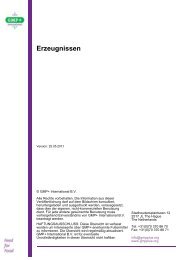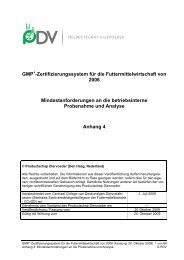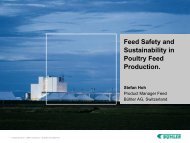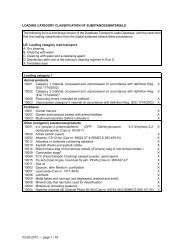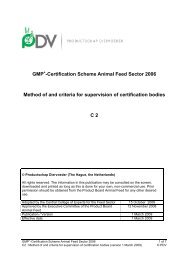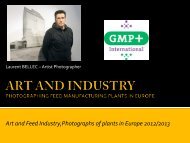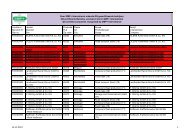Certification Scheme Animal Feed Sector 2006 ... - Gmpplus.org
Certification Scheme Animal Feed Sector 2006 ... - Gmpplus.org
Certification Scheme Animal Feed Sector 2006 ... - Gmpplus.org
Create successful ePaper yourself
Turn your PDF publications into a flip-book with our unique Google optimized e-Paper software.
ANNEX D: RESIDUE SAMPLING AND DETERMINATION IN CARGO SPACES<br />
FOLLOWING TRANSPORTATION OF PRODUCTS FOR WHICH A<br />
(RE)CLASSIFICATION INTO LOADING CATEGORIES HAS BEEN REQUESTED<br />
(ROAD TRANSPORT).<br />
Under the procedure for (re)classification of products in loading categories for transport, inspection agencies<br />
may be invited by GMP-certified transport companies to carry out the necessary work with respect to the<br />
taking of sample material for determining residual contamination or its absence.<br />
The work relating to these samples will be carried out by an EN 45004 accredited inspection <strong>org</strong>anisation<br />
where the inspection of the cargo space is part of the accredited activities..<br />
The transport company requesting the residue sampling should comply with the following additional<br />
conditions:<br />
a. Together with the application for inspection of the empty and cleaned cargo space the applicant<br />
transport company will provide a guarantee that the cargo space is included in the quality system for<br />
recognition under the “<strong>Animal</strong> <strong>Feed</strong> Transport Certificate”;<br />
b. the applicant transport company provides, with the application for sampling of the cargo space, a list<br />
of the 10 previous loads carried in the cargo space prior to the inspection (This list will be signed and<br />
dated by the Quality Manager of the transport company);<br />
c. the applicant transport company provides, with the application for inspection of the cargo space, a list<br />
of the cleaning and disinfection carried out after the 5 loads carried in the cargo space prior to the<br />
inspection;<br />
d. the applicant transport company declares that it is willing to issue further information on the nature<br />
and characteristics of the loads carried prior to the inspection.<br />
The inspecting company will, after the sampling has been carried out, issue a sample report informing the<br />
Quality Manager of the transport company that, on the basis of a visual inspection at the time of the<br />
sampling of the cargo space (at a date and time) that the cargo space has been found to be suitable for the<br />
transport of animal feeds subject to further examination with respect to residue contamination taking<br />
into consideration that which is determined in the rules for transport within the framework of the GMP<br />
standard for Road Transport <strong>Animal</strong> <strong>Feed</strong> <strong>Sector</strong>.<br />
The sampling is carried out on the basis of a random collection of load residues. Use is made of existing<br />
techniques (print plates, swabs, wall wash samples (sterile wipes or sponges)). In addition account should<br />
be taken during the random selection of the locations to be sampled of the critical contact points in a loading<br />
compartment:<br />
a. openings and feed-through points<br />
b. construction roughness/connections<br />
c. distinguish between low and high contact points<br />
d. covering material/clips/lid/hinge points/reinforcements.<br />
A cargo residue sample will be collected by the inspection company at a minimum of 8 different contact<br />
points. Each cargo residue sample is given a reference which refers to the contact point which was sampled<br />
and this information is also recorded in the sampling report.<br />
The residue samples are package in the right way by the inspection company, provided with an identification<br />
seal and made available to the company. The packaging and the identification seal are recorded in the<br />
sampling report.<br />
Representatives of the carriers of Agribulk will be invited to make an inventory of potential available<br />
inspection companies.<br />
The transport company will send the residue samples – together with a sample of the original product – for<br />
analysis /determination to an ISO 17025 accredited laboratory, or an animal feed laboratory accredited by<br />
means of the GMP’s internal inspection system for the determinations in question, with a request to<br />
determine whether there are residues present and, if so, in what concentrations.<br />
GMP+ <strong>Certification</strong> <strong>Scheme</strong> <strong>Animal</strong> <strong>Feed</strong> <strong>Sector</strong> <strong>2006</strong> 24 of 26<br />
Appendix 14 : Minimum requirements for Road Transport (version 16 November 2007) © PDV



